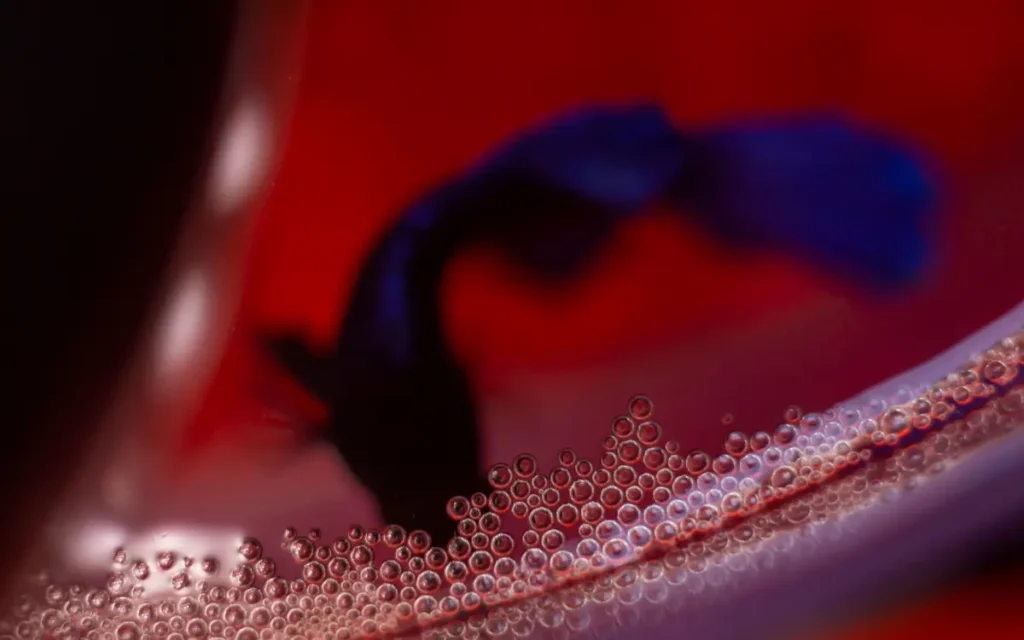Betta bubble nests are clusters of tiny bubbles on the water’s surface, crafted by male Betta fish.
This fascinating behavior is natural and common, often indicating a happy, healthy Betta.
But why should Betta owners pay attention to these delicate bubbles? They reveal insights into your Betta’s environment and well-being.
What is a Betta Bubble Nest?

Definition: A Betta bubble nest is a collection of small bubbles that male Betta fish create on the surface of the water. These nests appear as clusters or foam-like patches and are typically found floating in a corner of the tank or near plants.
Purpose: Male Bettas instinctively build these nests as part of their breeding behavior. The bubbles are created by the Betta blowing air and mixing it with saliva, which makes the bubbles durable and able to hold together.
Function: This unique nesting structure serves to protect eggs and provide a safe, oxygen-rich environment for the young.
Why Do Betta Fish Make Bubble Nests?
Primary Purpose: Reproduction. Male Bettas build these nests in preparation for mating, where the bubbles will serve as a safe haven for fertilized eggs and, eventually, baby Bettas (fry).
Breeding Process: Once the female releases eggs, the male collects and places them into the bubble nest. The nest provides essential oxygen for the eggs and keeps them secure, as the bubbles are sturdy enough to protect the eggs from floating away or sinking.
Instinctual Behavior: Interestingly, Betta fish may build bubble nests even without a female present or any intention of breeding. This behavior is largely instinctual, driven by a natural urge to prepare for potential offspring. A bubble nest often signals that the Betta feels comfortable and healthy in its environment.
When and How Often Do Bettas Build Bubble Nests?
Common Triggers:
- Betta fish build bubble nests when certain conditions make them feel comfortable and secure. Common triggers include warm water temperatures, as Bettas thrive in warmer environments (ideally around 78-80°F), and a stable, calm setting where the Betta feels safe.
- They may also build nests when their tank includes elements like plants or floating objects that create natural shelter.
Frequency:
- The frequency of bubble nest creation varies widely among individual Bettas. Some males may build nests as often as once a week, while others do so less frequently or even sporadically.
- Younger, healthier male Bettas are more likely to create bubble nests consistently, as they are generally more driven by the instinct to reproduce. However, each Betta has its own unique behavior, and some may build nests more often than others depending on factors like age, health, and temperament.
Factors That Influence Bubble Nest Building
Water Conditions:
- One of the most critical elements is water conditions. Bettas prefer clean, warm water, with an ideal temperature range of 78-80°F.
- Maintaining a stable temperature and clean environment encourages them to engage in natural behaviors like bubble nesting. Clean water also ensures that the bubbles hold together better, as debris or dirt can quickly break them apart.
Presence of a Female Betta:
- The presence of a female Betta nearby can significantly increase the likelihood of nest building. Male Bettas often create bubble nests when they sense a potential mate in the vicinity, even if they’re separated by a divider.
- This behavior is driven by their instinct to prepare a safe space for breeding. However, it’s not necessary to keep a female Betta close by, as males may build nests simply based on instinct alone.
Tank Environment:
- Lastly, the tank environment plays a crucial role in encouraging bubble nest creation. Bettas tend to nest more frequently in tanks that offer calm surroundings with minimal disturbances.
- Floating plants, such as water lettuce or duckweed, provide shelter, mimic natural conditions, and make Bettas feel secure. A calm environment without excessive movement or strong currents helps the bubbles stay intact, allowing Bettas to build and maintain their nests without disruption.
Should You Be Concerned if Your Betta Isn’t Building a Bubble Nest?
Lack of Nesting Behavior:
- If your Betta isn’t building a bubble nest, there’s usually no need for concern. Several factors can influence a Betta’s nesting behavior, including age, health, and temperament. Younger Bettas or those in poor health may be less inclined to create nests.
- Additionally, some Bettas are simply less motivated to build nests due to individual personality differences. Each Betta is unique, and some may never build a bubble nest despite being in a healthy and comfortable environment.
- Reassurance: A lack of bubble nesting doesn’t necessarily indicate a problem or unhappiness. While it’s a natural behavior, not all Bettas are frequent nest builders. They can still thrive without exhibiting this behavior, and it doesn’t affect their overall well-being.
- Encouraging Nesting:
- If you’d like to encourage bubble nest building, there are a few steps you can take. Adjusting tank conditions—such as maintaining clean water, a stable temperature of around 78-80°F, and adding gentle, floating plants—can create a more appealing environment.
- Reducing stressors, like minimizing tank disturbances and avoiding strong water currents, can also help. These small changes can make your Betta feel more secure, potentially sparking its instinct to build a bubble nest. However, remember that each Betta has its own preferences and behaviors.
What to Do if You See a Bubble Nest?

Avoid Disrupting the Nest:
- When you notice a bubble nest in your Betta tank, it’s a sign that your Betta feels comfortable and is engaging in natural behavior. You don’t need to take immediate action, but there are a few steps to maintain the nest and keep your Betta happy.
- First, try to avoid disrupting the nest by keeping water changes gentle and using a slow, careful approach. Avoid creating strong currents or bubbles that might disturb the nest.
- Tank Maintenance:
- If you need to clean the tank, use a siphon near the bottom, away from the surface where the nest is located. Maintaining a clean tank is essential, but do so in a way that leaves the bubble nest undisturbed.
- Breeding Considerations:
- If you’re considering breeding Bettas, you can introduce a female, but proceed with caution. Betta breeding requires careful monitoring, as male Bettas can become aggressive toward females. Make sure to have a separate tank or divider ready in case you need to separate them quickly.
- Additionally, be prepared for the responsibility of caring for the potential fry. If breeding isn’t your goal, simply enjoy observing your Betta’s unique behavior and the effort it has put into building its nest.
Fun Facts About Betta Bubble Nests
- Protective Instincts: Betta bubble nests are not only fascinating but also demonstrate impressive care by the male Betta. After building the nest, the male actively protects it by guarding the area and ensuring no disturbances.
- Parental Care: If eggs fall out of the nest, the male Betta gently retrieves them and places them back into the bubbles, showcasing his parental instincts.
- Species Variations: Interestingly, not all Bettas build nests in the same way. Different Betta species exhibit unique nesting behaviors, with some creating larger, more elaborate nests, while others may build smaller or fewer bubbles depending on their environment and temperament.

